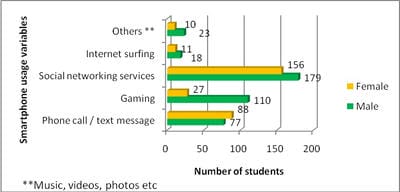Smart phone use and sleep disturbances, depression and anxiety in adolescents
P. Kulkarni V.1, Kumar L.2*, Reddi Naidu L.3
DOI: https://doi.org/10.17511/ijphr.2019.i2.03
1 Ved P. Kulkarni, Professor, Department of Community Medicine, Maharajah’s Institute of Medical Sciences, Vizianagaram, Andhra Pradesh, India.
2* L. Santosh Kumar, Assistant Professor, Department of Pediatrics, Maharajah’s Institute of Medical Sciences, Vizianagaram, Andhra Pradesh, India.
3 L. Venkata Reddi Naidu, Post Graduate, Department of Community Medicine, Maharajah’s Institute of Medical Sciences, Vizianagaram, Andhra Pradesh, India.
Background: Keeping in mind about the rapid advancement and extensive use of mobile phones, and their immense effect on communication and interactions, it is important to study potential negative health effects of mobile phone exposure especially among adolescents. Material & Methods: A cross-sectional study was conducted to assess smartphone use and sleep disturbances, depression in adolescents among 469 adoloscents studying in Government Polythechnic college, Vizianagaram using a structured questionnaire containing details of demographics, educational status, purpose of using the smart phone etc, PSQI and DASS 21 for sleep quality, depression stress and anxiety. Results: The prevalence of smart phone addiction among participants was 29.63% (30.08% in males and 29.21% in females). Factors associated with smartphone addiction in male students were use of gaming apps and internet surfing. Significant factors for female students were use ofuse of social networking services and communication services (Calling and texting). Depression, anxiety and quality of sleep are significantly associated with smart phone addiction. Conclusion: Smartphone addiction was common among the polyechnic students investigated. This study identified associations between smartphone usage, psycho-behavioral factors, and smartphone addiction, and the associations differed between males and females. These results suggest the need for interventions to reduce smartphone addiction among degree students. The results of this study suggest that adolescents might benefit from education regarding sleep hygiene and the risks of electronic media use at night.
Keywords: Smartphone, Adolescent, Addiction, Depression, Anxiety
| Corresponding Author | How to Cite this Article | To Browse |
|---|---|---|
| , Assistant Professor, Department of Pediatrics, Maharajah’s Institute of Medical Sciences, Vizianagaram, Andhra Pradesh, India. Email: |
Kulkarni VP, Kumar LS, Naidu LVR. Smart phone use and sleep disturbances, depression and anxiety in adolescents. Public Health Rev Int J Public Health Res. 2019;6(2):61-67. Available From https://publichealth.medresearch.in/index.php/ijphr/article/view/101 |


 ©
© 